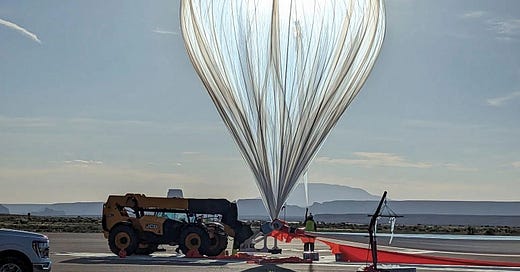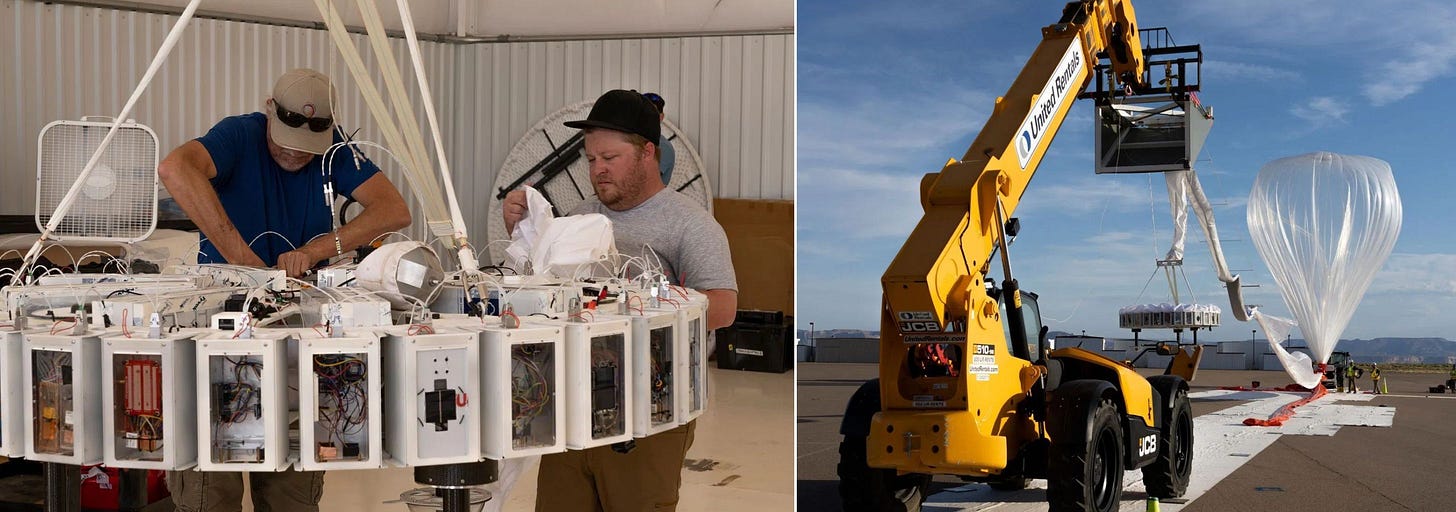After a hiatus of a few weeks -a little more than two months in fact- I’m resuming the edition of this humble bulletin. As you will see, the name changed from Weekly Balloon News to the more realistic World Balloon News to be as honest as possible on the scope and the periodicity of this newsletter.
To resume the contact, I will be making a very brief overview of all relevant balloon activity since the last issue on June 7th. I will be as synthetic as possible to maintain an affordable reading time.
Let’s start
Two manned flight tests by Iwaya Giken in Japan
During June and July, the Japanese startup Iwaya Giken performed two test flights of their TYPE-9 capsule. Both flights were conducted from the runway at Shintoku Airfield in Hokkaido, Japan.
The TYPE-9 is a new single-seat experimental capsule that is part of the scaling-up developing process the firm is carrying out with the objective of offering in the future manned flights to the public.
The first flight took place on June 15. The manned capsule reached a maximum altitude of 517 meters and flew a distance of 2.5km in 32 minutes.
On July 23, a second test was held at the same location, but this time as the balloon was planned to ascend above 4000 meters, at some point the capsule was sealed allowing the pilot to reach a maximum altitude of 6072 meters without wearing any oxygen system. Total flight time was 2 hours and 11 minutes during which the balloon traveled more than 26 kilometers.
Under these lines can be seen a video published by the firm about the second test.
Intense and diverse flight activity by Aerostar
Besides the presentation of their new logo and their Instagram account, the balloon firm from South Dakota has been very active during the period I’m reporting.
Most of the missions carried out were what Aerostar calls IRAD or Internal Research And Development test flights aimed to train different wind models. During these missions, the balloons gather data and measure the winds comparing the obtained information with the outcome of the models to improve them. This will help in the future the planning of long-duration balloon flights. All of these flights were launched from Hurley in South Dakota.
HBAL631 and HBAL632 were launched on June 13 and flew for 48 and 43 hours respectively.
The next day was launched a zero-pressure balloon (denominated by Aerostar as “Cyclone”) containing experiments from students from 20 middle and high schools in the United States. These experiments were flown sponsored by NASA’s TechRise Student Challenge for more than 7 hours.
Before the end of June, three more thunderheads were launched: HBAL633 on June 20 for a flight duration of 35 hours, HBAL634 on June 21 to perform a long-duration mission of 20 days, and finally HBAL 635 on June 28 which remained aloft a little more than 8 days.
July started with a Thunderhead launched on the 11th (HBAL 636) for an IRAD flight of a little more than two days. On July 21, two balloons were launched: another cyclone zero-pressure “cyclone” platform carrying more payloads for NASA’s TechRise Student Challenge and later that same day another IRAD mission onboard a Thunderhead balloon (HBAL 638). During the following weekend, this balloon transmitted impressive images on Aerostar’s youtube channel as part of the firm’s participation in the Sioux Falls Air Show of which they were one of the main sponsors.

On July 25, HBAL628 a Thunderhead mission aimed to perform a multi-month long-duration mission completed its flight after remaining 83 days aloft and hovering across the west half of the United States. The landing site was 20 km south of Atkinson in Nebraska.
Finally, on Aug. 1st. a last Thunderhead launch was performed from Hurley (SD) with the presence on site of members of TCOM’s Advisory Board. The mission endured 3 days aloft landing also in Nebraska.
Last but not least, in the first days of August the firm moved a team to southern California to launch five more Thunderheads from the Barstow-Daggett Airport.
Of the five balloons launched, HBAL650 failed within an hour and landed 25 km NE of the launch site on August 5, while another two completed their flights: HBAL651 remained in flight for 2 days and 7 hours before landing near Barstow, and HBAL652 (launched on Aug. 11) landed after almost 16 hours of flight NE of Paso Robles, California.
At the moment of wrapping up this edition, only two still remain in flight: HBAL648 launched also on Aug. 5 and HBAL649 launched on Aug. 11. Both are floating above the Pacific Ocean offshore of Los Angeles.
World View completes a balloon flight for NASA
The Tucson-based balloon firm performed a balloon launch from the Municipal Airport in Page, Arizona on July 24th.
The objective of the flight was to transport 30 experiments by students from high schools in the United States as part of NASA’s TechRise Student Challenge.
The zero-pressure balloon flew over four hours at about 96,000 feet before landing in Utah.
This was the first balloon mission performed by the company since the launch campaign in Hawaii in March 2023 on which two Stratollite balloons were lost in the Pacific Ocean.
Balloon launch by NASA from Palestine. The first one since 2018
NASA’s balloon program conducted on July 16 the first balloon launch in more than five years, at the historical circular launch pad of the Columbia Scientific Balloon Facility in Palestine, Texas. The small balloon was hand-launched at 13:04 utc and remained in flight for 6 hours and 20 minutes at ~ 125.000 ft before landing West of Blackwell, Texas.
The objective of the flight was to launch an experiment called WHATSUP which stands for Water Hunting Advanced Terahertz Spectrometer on a Ultra-small Platform and was developed at Nasa's Jet Propulsion Laboratory to address the key question of the origin of Earth's water, and more broadly solar system water, which still remains uncertain.
This was the second flight of the instrument after a first mission from Fort Sumner (NM) in 2021. More details and images of the flight are available in StratoCat.
Strato Sciences 2023 balloon launch campaign starts in Canada
The seventh balloon campaign since the inception of the Timmins Stratospheric Balloon Launch base started on August 8th, with the flight of the COMICS mission. The Strato Sciences initiative is a cooperative effort between the space agencies of Canada and France.
The balloon with a volume of 150.000 cubic meters was launched as Nimbus-1 (generic denomination for flights under the French balloon program) at 11:00 utc and ended its flight at 18:45 utc. The landing site was located in the Chapleau Crown Game Preserve in Ontario.

The multi-instrumented pointed gondola developed by CNES (a.k.a. Carmencita) transported experiments provided by institutions from France, Italy, and Canada. More details are available in the flight sheet in StratoCat.
Three more balloon launches are planned for the rest of the campaign which will end in late August.
The contents of this newsletter as well as the entire StratoCat website are free and available to all readers and will continue to be that way. I didn't even want to subject eventual visitors to the torture of advertisements. However, if you want, you can help to keep this project alive with just the equivalent of the price of a cup of coffee.
Balloon launch campaign at Taiki by Jaxa
The Japanese space agency JAXA is carrying out its yearly balloon launch campaign at the Taiki Aerospace Research Field (TARF) in Hokkaido.
So far four missions were successfully accomplished.
The first two balloons were launched on successive days in July carrying an experiment denominated RERA (Rubber balloon Experiment for Reentry capsule with thin-type Aeroshell). The goal was to test a lightweight, large, thin-shell conical aeroshell able to descend to the earth without a parachute. The vehicle is being developed by Japan's Space Transportation System Laboratory as part of a larger project to allow sample return from deep space.
The first mission nomenclated as flight BS23-07 was carried out on July 8 while the second one was launched the next day as BS23-09. Both missions were launched at 5:31 Japan Standard Time (JST).

The next balloon flight of the campaign took place on July 26. Mission B23-05 was devoted to performing a drop test and autonomous flight of MABE-2, an acronym of Mars Airplane Balloon Experiment Two a development and research effort to study the aerodynamic design of a future plane aimed to fly in the Martian atmosphere.
Finally, the four flight was carried out the very next day as mission B23-06. The balloon transported an experiment called GRAMS (Gamma-Ray and AntiMatter Survey) which is a proposed next-generation experiment to observe gamma rays and to perform indirect dark matter searches with antimatter using a brand-new detector.
Detailed accounts of the development of these two flights and detailed descriptions of the experiments and images are available here for MABE-2 and here for GRAMS.
As I mentioned in the last issue, only remains one experiment to be launched during this year’s campaign to evaluate a propeller able to modify and alter the course of a balloon in flight in the stratosphere.
New flight test of SCEYE’s stratospheric airship
On July 1st, 2023, SCEYE Inc. performed the second test of the year of their stratospheric airship. As usual, the vehicle was launched from the company's facility located close to the North end of the 17/35 runway in the Roswell Air Center in New Mexico.
The flight endured about 4 hours with a maximum altitude of flight about 61.000 feet. The craft landed North of Lovington, New Mexico. So far, it was the more successful mission of the company.
The primary purpose of the flight test was to evaluate a novel launch method that could increase reliability during the initial ascent phase of flight and simplify the overall launch procedure. The platform also carried a high-resolution camera, which was developed in-house by SCEYE for ground mapping with partners like the USGS and NASA.
The image below was obtained during the flight.
In Brief
In the umpteenth iteration of the Chinese spy balloon affair, this time it seems that DARPA is determined to get hold of one of those devices if they appear again over sovereign US territory. At least that is what emerges from an article published by Steve Trimble in The Weekly Debrief of Aviation Week, a few days before the circulation of this newsletter.
In the article, I had the pleasure of offering my views on the matter and proposing possible solutions. In case DARPA adopts my suggestions I hope that I can get my deserved recognition ;-).In early July, the French group HEMERIA presented -among other projects- at the International Paris Air Show Le Bourget 2023 their maneuverable balloon BALMAN. The French firm showed a mockup of the balloon they are developing to allow station keeping and maneuvering for the benefit of the scientific and defense communities.
New contents in StratoCat
It will be impossible to maintain in readable form this issue of World Balloon News if I dare to publish here all the new additions on which I have worked since the last issue.
So, in honor of brevity, I will pass off this until the next time we meet.







